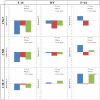Does the integration of haptic and visual cues reduce the effect of a biased visual reference frame on the subjective head orientation?
- PMID: 22509295
- PMCID: PMC3324492
- DOI: 10.1371/journal.pone.0034380
Does the integration of haptic and visual cues reduce the effect of a biased visual reference frame on the subjective head orientation?
Abstract
Background: The selection of appropriate frames of reference (FOR) is a key factor in the elaboration of spatial perception and the production of robust interaction with our environment. The extent to which we perceive the head axis orientation (subjective head orientation, SHO) with both accuracy and precision likely contributes to the efficiency of these spatial interactions. A first goal of this study was to investigate the relative contribution of both the visual and egocentric FOR (centre-of-mass) in the SHO processing. A second goal was to investigate humans' ability to process SHO in various sensory response modalities (visual, haptic and visuo-haptic), and the way they modify the reliance to either the visual or egocentric FORs. A third goal was to question whether subjects combined visual and haptic cues optimally to increase SHO certainty and to decrease the FORs disruption effect.
Methodology/principal findings: Thirteen subjects were asked to indicate their SHO while the visual and/or egocentric FORs were deviated. Four results emerged from our study. First, visual rod settings to SHO were altered by the tilted visual frame but not by the egocentric FOR alteration, whereas no haptic settings alteration was observed whether due to the egocentric FOR alteration or the tilted visual frame. These results are modulated by individual analysis. Second, visual and egocentric FOR dependency appear to be negatively correlated. Third, the response modality enrichment appears to improve SHO. Fourth, several combination rules of the visuo-haptic cues such as the Maximum Likelihood Estimation (MLE), Winner-Take-All (WTA) or Unweighted Mean (UWM) rule seem to account for SHO improvements. However, the UWM rule seems to best account for the improvement of visuo-haptic estimates, especially in situations with high FOR incongruence. Finally, the data also indicated that FOR reliance resulted from the application of UWM rule. This was observed more particularly, in the visual dependent subject.
Conclusions: Taken together, these findings emphasize the importance of identifying individual spatial FOR preferences to assess the efficiency of our interaction with the environment whilst performing spatial tasks.
Conflict of interest statement
Figures









Similar articles
-
Egocentric reference frame bias in the palmar haptic perception of surface orientation.Psychon Bull Rev. 2014 Aug;21(4):955-60. doi: 10.3758/s13423-013-0552-7. Psychon Bull Rev. 2014. PMID: 24254809 Free PMC article.
-
Perceived self-orientation in allocentric and egocentric space: effects of visual and physical tilt on saccadic and tactile measures.Brain Res. 2008 Nov 25;1242:231-43. doi: 10.1016/j.brainres.2008.07.075. Epub 2008 Jul 29. Brain Res. 2008. PMID: 18706895
-
Individual differences in the ability to identify, select and use appropriate frames of reference for perceptuo-motor control.Neuroscience. 2010 Sep 1;169(3):1199-215. doi: 10.1016/j.neuroscience.2010.05.072. Epub 2010 Jun 4. Neuroscience. 2010. PMID: 20570716
-
The haptic perception of spatial orientations.Exp Brain Res. 2008 May;187(3):331-48. doi: 10.1007/s00221-008-1382-0. Epub 2008 Apr 30. Exp Brain Res. 2008. PMID: 18446332 Free PMC article. Review.
-
Rod and frame test parameters for neuropsychology studies.J Clin Exp Neuropsychol. 2024 Jul;46(5):466-487. doi: 10.1080/13803395.2024.2356297. Epub 2024 Jun 14. J Clin Exp Neuropsychol. 2024. PMID: 38873989 Review.
Cited by
-
Sensorimotor and cognitive factors associated with the age-related increase of visual field dependence: a cross-sectional study.Age (Dordr). 2015 Aug;37(4):9805. doi: 10.1007/s11357-015-9805-x. Epub 2015 Jun 30. Age (Dordr). 2015. PMID: 26122710 Free PMC article.
-
Visiting Richard Serra's "Promenade" sculpture improves postural control and judgment of subjective visual vertical.Front Psychol. 2014 Dec 12;5:1349. doi: 10.3389/fpsyg.2014.01349. eCollection 2014. Front Psychol. 2014. PMID: 25566107 Free PMC article.
-
Age-related kinematic performance should be considered during fast head-neck rotation target task in individuals aged from 8 to 85 years old.PeerJ. 2019 Jun 10;7:e7095. doi: 10.7717/peerj.7095. eCollection 2019. PeerJ. 2019. PMID: 31218133 Free PMC article.
-
The Subjective Visual Vertical and the Subjective Haptic Vertical Access Different Gravity Estimates.PLoS One. 2015 Dec 30;10(12):e0145528. doi: 10.1371/journal.pone.0145528. eCollection 2015. PLoS One. 2015. PMID: 26716835 Free PMC article.
-
Combined influence of visual scene and body tilt on arm pointing movements: gravity matters!PLoS One. 2014 Jun 12;9(6):e99866. doi: 10.1371/journal.pone.0099866. eCollection 2014. PLoS One. 2014. PMID: 24925371 Free PMC article. Clinical Trial.
References
-
- Fourre B, Isableu B, Bernardin D, Gueguen M, Giraudet G, et al. The role of body centre of mass on haptic subjective vertical. Neurosci Lett. 2009;465:230–234. S0304-3940(09)00912-4 [pii];10.1016/j.neulet.2009.07.005 [doi] - PubMed
-
- Isableu B, Rezzoug N, Mallet G, Bernardin D, Gorce P, et al. Velocity-dependent changes of rotational axes in the non-visual control of unconstrained 3D arm motions. Neuroscience. 2009;164:1632–1647. S0306-4522(09)01426-2 [pii];10.1016/j.neuroscience.2009.08.065 [doi] - PubMed
-
- Isableu B, Ohlmann T, Cremieux J, Vuillerme N, Amblard B, et al. Individual differences in the ability to identify, select and use appropriate frames of reference for perceptuo-motor control. Neuroscience. 2010;169:1199–1215. S0306-4522(10)00812-2 [pii];10.1016/j.neuroscience.2010.05.072 [doi] - PubMed
-
- Guerraz M, Poquin D, Luyat M, Ohlmann T. Head orientation involvement in assessment of the subjective vertical during whole body tilt. Percept Mot Skills. 1998;87:643–648. - PubMed
-
- Guerraz M, Poquin D, Ohlmann T. The role of head-centric spatial reference with a static and kinetic visual disturbance. Percept Psychophys. 1998;60:287–295. - PubMed
Publication types
MeSH terms
LinkOut - more resources
Full Text Sources

